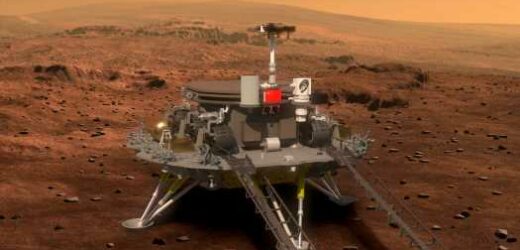China has sent astronauts to space. Its robotic probes have been to the moon and back. On Saturday (it will still be Friday in the United States) it will attempt a landing on Mars, a difficult operation that has ended in fiery failure many times for space programs that have tried it.
By arriving at Mars and orbiting the planet in February, the country’s space program further confirmed its place among the top tier of agencies exploring the solar system. But a red planet landing is in a class of its own, and if China manages to orbit, land on and deploy a rover to Mars in a single mission, it will have pulled off an uncommon achievement in the history of spaceflight.
When is the landing and how can I follow it?
The China National Space Administration announced a potential landing date in the “early morning of May 15,” Beijing time. That would occur during the early evening hours of Friday, May 14.
The announcement also said the landing attempt could occur as late as May 19, suggesting that there are backup opportunities should something prevent Saturday’s trip to the surface.
The country’s state media services have not yet announced live coverage of the mission’s landing attempt. They have recently started providing more up to the minute video of Chinese space activities, such as live streams of the rocket launch that carried a piece of the country’s space station to orbit. Additionally, China’s space agency released recordings of their most recent successful robotic moon landing. We will add links to a stream of any live video coverage if one becomes available.
What is China’s mission to Mars?
The Tianwen-1 mission launched from Earth last July, aiming to take advantage of the window of time every two years when Mars and Earth are closest together during their voyages around the sun.
The mission consists of an orbiter, a lander and a rover.
The Tianwen-1 Spacecraft
China’s mission to Mars features a probe that will land on the planet with help from a parachute.
Lander
A parachute attached to a protective SHELL will slow the lander’s descent. Next, a set of STRUTS will deploy midair. Once on the surface, a RAMP will slide out so the rover can drive off.
Orbiter
After the orbiter reaches Mars, the landing probe will detach and descend to the planet’s surface.
Rover
Four solar panel wings will unfurl after landing.
Orbiter
After the orbiter reaches Mars, the landing probe will detach and descend to the planet’s surface.
Lander
A parachute attached to a protective SHELL will slow the descent. Next, a set of STRUTS will deploy midair. After landing, a RAMP will slide out so the rover can drive off.
Rover
With four solar panels
Orbiter
After the orbiter reaches Mars, the landing probe will detach and descend to the planet’s surface.
Rover
Four solar panel wings will unfurl after landing.
Lander
A parachute attached to the SHELL will slow the descent. Next, four STRUTS will deploy midair. After landing, a RAMP will slide out so the rover can drive off.
By Eleanor Lutz | Source: China National Space Administration and China Central Television
The Tianwen-1 orbiter pulled into Martian orbit on Feb. 10, since then, it has been circling at a safe distance, preparing for the landing attempt.
The unnamed landing craft carries a rover, which was named Zhurong after a god of fire in Chinese folk tales. That name beat out nine other semifinalists that were announced in February.
The mass of Zhurong is about 240 kilograms, or about 530 pounds. That is a bit heftier than the Spirit and Opportunity rovers that NASA landed on Mars in 2004, but only about one-fourth the mass of Curiosity and Perseverance, the two NASA rovers currently operating on Mars.
It may be days after the touch down that the rover rolls off the lander. Like Spirit and Opportunity, Zhurong will be powered by solar panels. For Perseverance and Curiosity, nuclear batteries turn heat released by the decay of radioactive plutonium into electricity.
The rover’s seven instruments include cameras, ground-penetrating radar, a magnetic field detector and a weather station.
This was not China’s first attempt at a Mars mission. That was Yinghuo-1, which failed nearly 10 years ago, although through no fault of the country’s own. That spacecraft burned up in Earth’s atmosphere when the Russian rocket it was traveling on failed in flight.
Where is the rover landing and what will it study?
Its destination is Utopia Planitia, or “Nowhere Land Plain,” a huge basin a couple of thousand miles wide in the northern hemisphere that was most likely carved out by a meteor impact. The same region was visited by NASA’s Viking 2 lander in 1976.
The plains are part of the northern lowlands of Mars. If there was once bountiful water on the red planet a few billion years ago, this region could have been underwater, part of an ocean covering the upper part of the planet. Utopia Planitia lies lower than features that have been proposed as two sets of shorelines, remnants from such early Martian oceans.
Some of the water from that hypothesized ocean may once have percolated underground, still frozen there today. In 2016, scientists using a radar instrument on NASA’s Mars Reconnaissance Orbiter concluded there is indeed much ice there — as much water as Lake Superior spread over an area bigger than New Mexico.
One goal of the Tianwen-1 mission is to better understand the distribution of ice in this region, which future human colonists on Mars could use to sustain themselves.
In a virtual conference organized on Friday by Weibo, a popular Chinese social media platform, several scientists debated the reasons to explore Mars, with one saying that the planet’s evolution could hold lessons for changes happening on Earth now.
“The purpose is to better protect our Earth itself,” Jiao Weixin, a professor of geophysics at Peking University, said in the forum. “I think this is the most fundamental purpose of our deep space exploration.”
Why is landing on Mars so difficult?
Landing on the red planet is perilous — NASA engineers refer to it as seven minutes of terror when its rovers, most recently Perseverance, arrive.
Because Tianwen-1 is already in orbit around Mars, its incoming speed will not be quite as fast as Perseverance’s. Thus, China’s lander will require a bit of extra terror — nine minutes — for the landing, The Global Times reported on Friday, citing experts. The probe will also be operating on its own, as signals currently take 17 minutes, 42 seconds to travel between Mars and Earth.
Spacecraft descend toward Mars at a high speed and the thin atmosphere does not do enough to slow the trip to the ground. The shock waves of air compressed by the speeding capsule generate extreme heat that must be absorbed or dissipated. A number of Soviet, NASA and European missions have crashed.
Only NASA has reached the surface of Mars intact more than once. The landings of its largest rovers, Curiosity and Perseverance, have relied on parachutes to slow the spacecraft, shields to dissipate the heat from atmospheric friction and intricate systems called sky cranes. These were basically rocket-powered jetpacks carrying the rovers beneath them and lowering them to the surface on cables before flying safely away from the landing zone.
For the Tianwen mission, a cone-shape entry capsule will carry the lander and rover through the atmosphere. A heat shield will protect the spacecraft from superheated gases as it speeds through the top of the atmosphere. Then the friction of the thin Martian air is to help it slow down — by about 90 percent, Tan Zhiyun, a designer at the China Academy of Space Technology, told the Global Times, a newspaper controlled by the Communist Party.
At a lower altitude, the heat shield will be jettisoned. At the next step the parachute and the top nose-shaped piece will be discarded. Firing a rocket engine, the four-legged lander, similar in design to the Chang’e-3 and Chang’e-4 lunar landers, will hover briefly as it searches for a safe spot and descend toward a safe powered landing.
Claire Fu contributed research.
Source: Read Full Article




